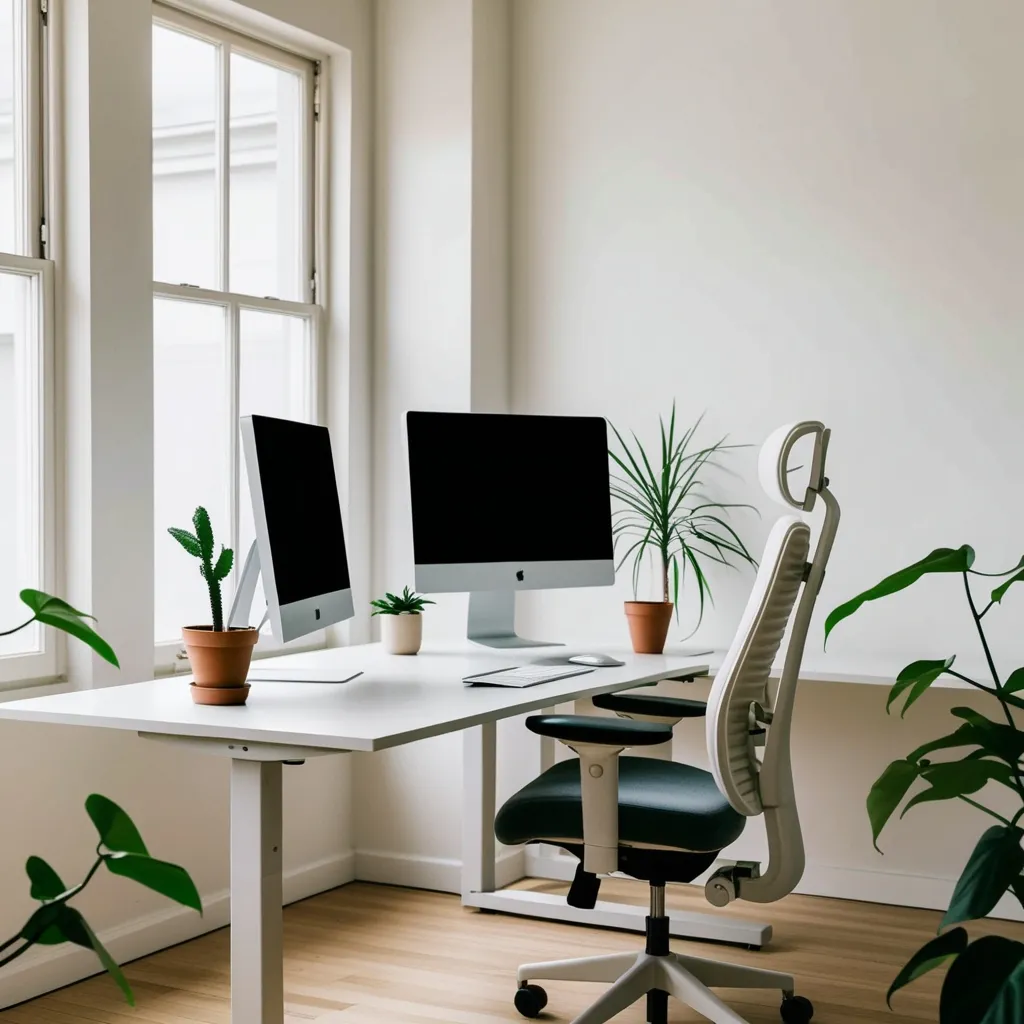Creating a Smart and Ergonomic Home Office: The Ultimate Guide
Working from home has become the new normal for many of us. But let’s face it, sitting at a makeshift desk all day can be a real pain in the neck - literally! That’s why it’s crucial to set up a home office that’s not just comfy, but also helps you stay productive and healthy. So, let’s dive into the world of ergonomics and turn your workspace into a productivity powerhouse!
The Chair: Your Butt’s New Best Friend
First things first, let’s talk about where you park your rear end all day. A good chair is like a supportive friend - it’s got your back, literally! Look for one that’s adjustable and gives your spine the TLC it deserves. No fancy ergonomic chair? No problem! Get creative with what you’ve got. A firm cushion or a rolled-up towel can work wonders for your posture. Your back will thank you later!
Monitor Magic: Eyes Up, Chin Down
Next up, let’s tackle that screen you’re staring at all day. Position it right, and you’ll avoid turning into the Hunchback of Notre Dame. Place your monitor directly in front of you, with the top of the screen at or just below eye level. It’s like giving your neck a mini-vacation! And if you’re working on a laptop, consider using an external monitor or a laptop stand. Your neck and eyes will be forever grateful.
Keyboard and Mouse: Wrist Whisperers
Now, let’s talk about those busy hands of yours. Keep your keyboard and mouse within easy reach, like they’re your trusty sidekicks. Your wrists should be straight, not bent like a contortionist. If you need a little extra support, try a wrist rest. It’s like a tiny pillow for your hands!
Let There Be Light!
Lighting is the unsung hero of any workspace. Natural light is your best bet, so try to set up shop near a window if you can. But watch out for glare on your screen - nobody wants to work while squinting! If natural light isn’t an option, a good desk lamp can be your new best friend. Just make sure it doesn’t turn your monitor into a mirror.
Happy Feet, Happy You
Don’t forget about those feet of yours! They should be flat on the floor, or resting on a footrest if you’re vertically challenged like me. No fancy footrest? No worries! A stack of books or even a shoebox can do the trick. It’s all about getting creative with what you’ve got.
Break It Up!
Remember, sitting is the new smoking. Take regular breaks to stand up, stretch, and maybe even do a little dance (when no one’s watching, of course). Your body will thank you, and you might even come up with your next brilliant idea while you’re at it!
Stand Up for Yourself
Speaking of standing, why not mix things up with a sit-stand desk? It’s like giving your body a mini workout throughout the day. No fancy desk? No problem! Use a high counter, shelf, or even an ironing board to create a DIY standing desk. Just be careful not to get too caught up in your work and forget to sit down occasionally!
Make It Yours
Your workspace should fit you like a glove. Avoid using the couch as your office - it might be comfy, but your body won’t thank you in the long run. Instead, create a dedicated space that’s all yours. Use whatever you have around the house to make it perfect. Remember, one size doesn’t fit all when it comes to ergonomics!
Beyond the Physical: Mental Ergonomics
Ergonomics isn’t just about physical comfort - it’s about mental well-being too. Keep your workspace tidy and organized. A cluttered desk can lead to a cluttered mind, and nobody wants that! Create clear work zones to help maintain a healthy work-life balance. Your mental health is just as important as your physical health, after all.
Eye Care: More Than Just a Staring Contest
Let’s talk about those peepers of yours. Staring at a screen all day can be tough on your eyes. Make sure your monitor isn’t too close or too far away - think Goldilocks, it needs to be just right! And watch out for screen glare. If you find yourself squinting more than smiling, it might be time to adjust your setup.
Fuel for Thought: Eating and Drinking Right
Don’t forget to fuel that brilliant brain of yours! Stay hydrated throughout the day - your body and mind will thank you. And while we’re at it, try to make healthy food choices. No one’s saying you can’t indulge in the occasional snack, but a balanced diet can do wonders for your productivity and overall well-being.
Move It, Move It!
Remember, your body was made to move! Try to incorporate some physical activity into your day. It doesn’t have to be a full-blown workout - even a quick stretch or a walk around the block can do wonders. Not only will it help your physical health, but it can also give your mind a much-needed refresh.
Mental Health: The Invisible Ergonomic Factor
Creating an ergonomic workspace isn’t just about physical comfort - it’s also about supporting your mental health. A well-designed workspace can significantly reduce stress and boost your overall well-being. Don’t forget to set boundaries for your work hours and take regular mental health breaks. Sometimes, the most productive thing you can do is step away from your desk and recharge.
Declutter for Clarity
A cluttered workspace can lead to a cluttered mind. Take some time to organize your space and minimize visual distractions. It’s amazing how much more focused and productive you can be in a clean, organized environment. Plus, it’s a great excuse to finally tackle that pile of papers you’ve been ignoring!
The Social Side of Remote Work
Working from home doesn’t mean you have to be a hermit. Make an effort to stay connected with your colleagues, even if it’s just through virtual coffee breaks or quick chat messages. Social interaction is important for our mental well-being, and it can help combat the isolation that sometimes comes with remote work.
Ergonomics on a Budget
You don’t need to break the bank to create an ergonomic workspace. Get creative with what you have at home. A stack of books can become a monitor stand, a rolled-up towel can serve as lumbar support, and a cardboard box can transform into a footrest. Remember, the best ergonomic solution is the one that works for you!
The Power of Plants
Consider adding some greenery to your workspace. Not only do plants look nice, but they can also improve air quality and boost your mood. Plus, caring for a plant can be a nice break from staring at your screen all day.
Noise Management
If you’re working in a noisy environment, consider investing in some noise-cancelling headphones or using white noise to help you focus. Creating a quiet, distraction-free environment can do wonders for your productivity and stress levels.
The Importance of a Good Night’s Sleep
Remember, good ergonomics start before you even sit down at your desk. Getting a good night’s sleep is crucial for maintaining focus and productivity throughout the day. Establish a consistent sleep schedule and create a relaxing bedtime routine to ensure you’re well-rested and ready to tackle each workday.
Ergonomics Beyond the Desk
Don’t forget about ergonomics when you’re not at your desk. If you frequently take calls, consider using a headset or earbuds to avoid neck strain from cradling your phone. And if you’re using a tablet or smartphone for work, be mindful of your posture and try to bring the device up to eye level rather than hunching over it.
The Journey, Not the Destination
Remember, creating an ergonomic workspace is an ongoing process. What works for you today might need tweaking tomorrow. Listen to your body, make adjustments as needed, and don’t be afraid to experiment with different setups.
In conclusion, creating a smart and ergonomic home office is about more than just buying fancy equipment. It’s about creating a space that supports your physical and mental well-being, boosts your productivity, and makes work feel a little less like, well, work! So go ahead, give these tips a try. Your body, mind, and work performance will thank you. Now, if you’ll excuse me, I think it’s time for a quick stretch break!






